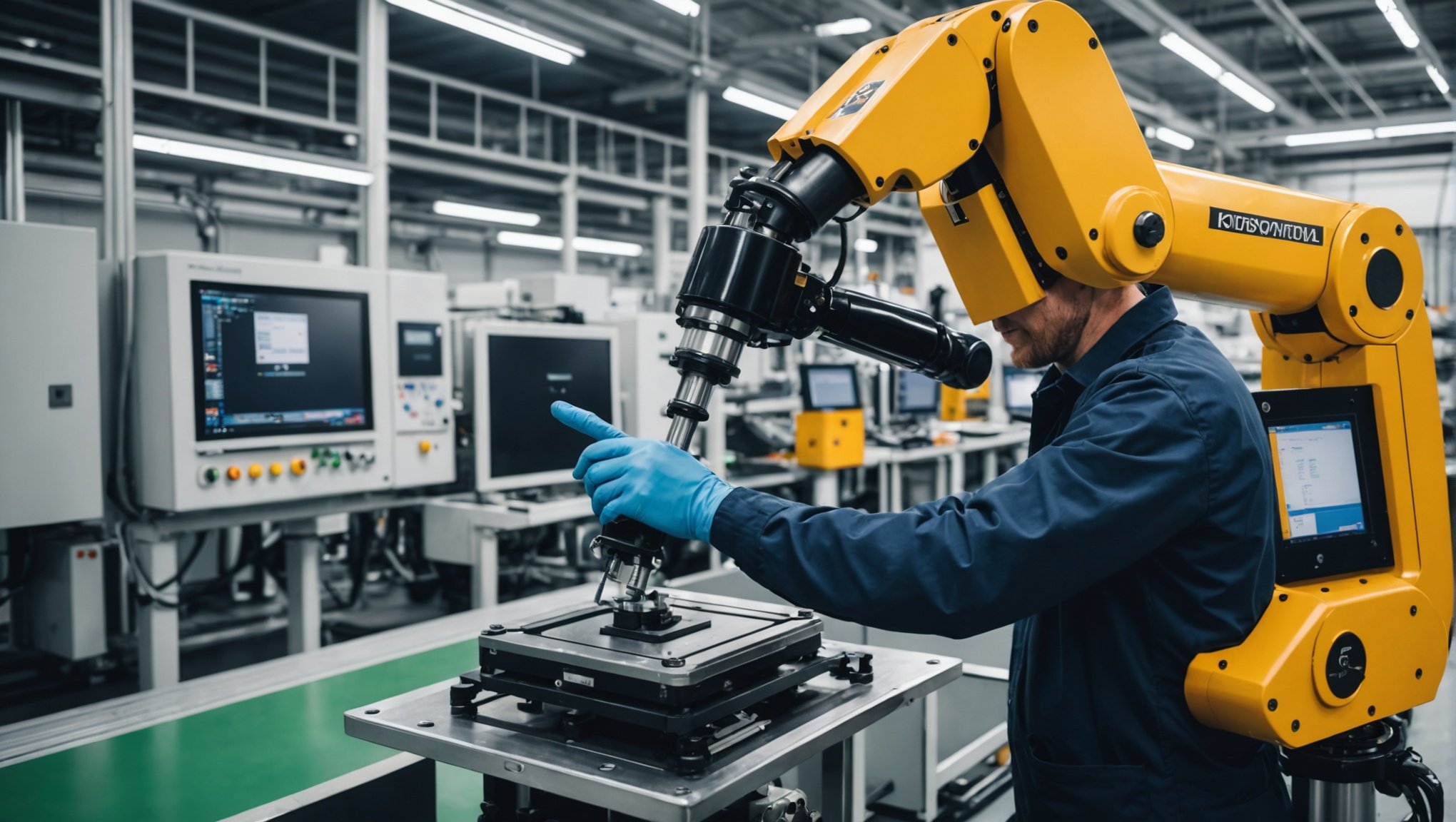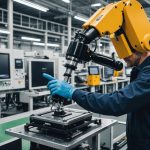Transforming Automated Quality Control: The Powerful Role of Machine Vision
In the ever-evolving landscape of manufacturing, the integration of advanced technologies has become a cornerstone for enhancing efficiency, accuracy, and product quality. One of the most significant advancements in this realm is the deployment of machine vision technology in automated quality control. This article delves into the transformative impact of machine vision on quality control processes, highlighting its benefits, applications, and the future of this technology in the manufacturing industry.
The Evolution of Machine Vision in Manufacturing
Machine vision, once a concept that seemed like science fiction, has now become an integral part of manufacturing automation and industrial imaging. Over the decades, the capabilities of machine vision have evolved dramatically, driven by advancements in technology and a significant reduction in costs.
In the same genre : Transforming Logistics: How AI Enhances Operational Efficiency in the Industry
For instance, 30 years ago, a 1.4-megapixel machine vision camera would cost over $10,000, whereas today a 5-megapixel industrial camera can be purchased for less than $1,000[3]. This shift, coupled with the integration of artificial intelligence (AI) and deep learning, has elevated machine vision to new heights.
Real-Time Defect Detection and Quality Control
One of the most compelling advantages of AI-driven machine vision systems is their ability to detect defects in real-time. These systems continuously analyze visual, sensor, or process data to identify defects the moment they occur on the production line.
This might interest you : How Next-Gen Firewalls Revolutionize Enterprise Security: Unveiling Their Impact
“AI-powered quality control solutions are revolutionizing the industry by providing a more sophisticated, precise, and efficient approach to identifying defects,” notes an industry expert. By employing machine learning algorithms trained on extensive datasets of potential defects, these systems can spot even the slightest surface scratches, shape deformities, or irregularities that traditional inspection methods might overlook[2].
Here are some key ways machine vision enhances real-time defect detection:
- Immediate Intervention: Defects are identified and addressed immediately, preventing defective products from progressing further down the production line.
- Predictive Analytics: Machine learning models analyze historical production data to predict when and where defects are likely to occur, allowing for proactive measures to be taken[5].
- High Accuracy: AI-powered systems achieve human-level accuracy in detecting defects, especially in industries such as automotive, electronics, and pharmaceuticals, where defects may not be easily visible[2].
Automated Inspection and Training
Machine vision systems are not only about defect detection but also about enhancing the overall efficiency and quality of the manufacturing process. Here are a few ways they achieve this:
Closed-Loop Work Recognition
A closed-loop work recognition system integrates AI-driven recognition of assembly tasks in real-time, ensuring higher quality and efficiency across production lines. This approach virtually eliminates defects by actively training factory workers with video-based work instructions[1].
Rapid AI Vision Model Training
Unlike traditional systems that require weeks or months to build AI vision models, modern intuitive visual setup tools can build functional models in minutes. These tools generate AI training sets augmented for lighting, color, and geometry, eliminating the need for thousands of manually captured images and engineering expertise[1].
No-Code Assembly Builder
A no-code interface allows users to visually string together intricate manufacturing processes. Each step is represented as a visual tile, empowering users to add, delete, or rearrange processes with full version control, without the need for coding or data science skills[1].
Integration with Digital Tools and Industrial Automation
The full integration of machine vision systems with other digital tools and industrial automation equipment is crucial for maintaining consistent quality and efficiency throughout the production process.
Full Integration with Connected Tools
Machine vision systems can integrate with tools such as torque drivers, multimeters, and fluid dispensers to ensure seamless validation of tool sequences and real-time monitoring. This integration maintains consistent quality and efficiency, ensuring that every step of the production process meets the required standards[1].
Cloud-Based Quality Management Systems
Cloud-based quality management systems provide easy access to data and enable teams to collaborate from anywhere. These systems help businesses scale operations, manage demand, and maintain data security, making them a vital component of modern manufacturing[5].
Human-Like Vision and Mechanical Scene Memorization
One of the standout features of advanced machine vision systems is their ability to mimic human vision and adapt to various conditions.
Human-Like AI Vision
AI platforms that mimic human vision are highly resilient to changes in lighting, color, and physical orientation. These systems leverage multiple specialized AI models, including those for reading text, ingesting tool data, and understanding component orientation, achieving human-level accuracy in electro-mechanical assemblies[1].
Mechanical Scene Memorization
Deep memorization capabilities allow vision systems to adapt to mechanical float with human-like accuracy. These systems can learn from one assembly in a standard orientation and maintain high accuracy even with rotations of up to 45º and positional floats of up to 20º[1].
Industry-Specific Applications
Machine vision technology is transforming various industries by providing tailored solutions to their unique quality control challenges.
Automotive Industry
In the automotive industry, AI-powered machine vision systems inspect paint finishes, weld seams, and engine components with unparalleled precision. These systems can detect microscopic cracks in metal parts or uneven paint coatings, ensuring that only the highest-quality vehicles reach consumers. This not only reduces costly recalls but also enhances the overall reliability and safety of the vehicles produced[2].
Electronics Manufacturing
The electronics industry, particularly semiconductor manufacturing, demands an incredibly high level of precision. AI-driven defect detection systems employ optical inspection and microscopy to identify defects at the nanometer scale. By analyzing visual data in real-time, these systems ensure that products meet the stringent quality standards required in this industry[2].
Reducing Waste and Costs
One of the most significant benefits of AI-driven machine vision systems is their ability to reduce waste and costs associated with traditional quality control methods.
Automated Inspection
Automated quality control using AI helps reduce waste by catching defects early in the production process. This approach ensures that high-quality products reach the market more quickly, reducing the need for costly rework and recalls[5].
Predictive Maintenance
AI-driven systems can predict when machines need maintenance, preventing breakdowns that could affect product quality. This predictive capability minimizes downtime and ensures high assurance of quality control, particularly in industries like pharmaceuticals and food production[5].
Effective Communication and Collaboration
Digital transformation, facilitated by machine vision and other advanced technologies, enhances inter-departmental and team-level communication and collaboration.
Real-Time Data Sharing
Quality control-related information can be communicated instantly across departments through cloud-based systems. This ensures that all teams involved in the manufacturing process are aware of the quality standards and expectations, enabling faster and more effective problem-solving[4].
Visual Data Analysis
Visualization tools assist top management in comprehending complicated datasets, enabling quicker decision-making. For instance, real-time data from machine vision systems can be analyzed for patterns or trends, helping manufacturers spot quality issues before they become significant[4].
Practical Insights and Actionable Advice
For manufacturers looking to implement machine vision technology, here are some practical insights and actionable advice:
Start with Clear Objectives
Define clear objectives for what you want to achieve with machine vision. Whether it’s improving defect detection, enhancing worker training, or optimizing production processes, having clear goals will help you choose the right technology and implementation strategy.
Invest in Training
Ensure that your workforce is adequately trained to use and maintain machine vision systems. This includes training on the software, hardware, and any specific AI models being used.
Integrate with Existing Systems
Machine vision systems should be integrated with your existing manufacturing processes and tools. This ensures seamless operation and maximizes the benefits of automation.
Monitor and Adapt
Continuously monitor the performance of your machine vision systems and adapt as necessary. This includes updating AI models, adjusting parameters, and addressing any issues that arise.
Machine vision technology, powered by AI and deep learning, is revolutionizing the manufacturing industry by transforming automated quality control processes. With its ability to detect defects in real-time, automate inspection and training, and integrate with other digital tools, machine vision is setting a new standard for quality control.
As manufacturers continue to adopt this technology, they will see significant improvements in efficiency, accuracy, and product quality. Whether you are in the automotive, electronics, or any other industry, machine vision is an essential tool for maintaining high quality standards and staying competitive in today’s fast-paced manufacturing environment.
Table: Key Benefits of Machine Vision in Quality Control
| Benefit | Description |
|---|---|
| Real-Time Defect Detection | Identifies defects as they occur, preventing defective products from progressing. |
| Predictive Analytics | Predicts when and where defects are likely to occur, enabling proactive measures. |
| Automated Inspection | Automates the inspection process, reducing human error and increasing efficiency. |
| Rapid AI Vision Model Training | Builds functional AI models in minutes, reducing the need for extensive training data. |
| Human-Like Vision | Mimics human vision, adapting to changes in lighting, color, and physical orientation. |
| Mechanical Scene Memorization | Adapts to mechanical float with high accuracy, even with rotations and positional changes. |
| Integration with Digital Tools | Integrates with tools like torque drivers and multimeters for seamless validation and monitoring. |
| Reduced Waste and Costs | Catches defects early, reducing rework and recalls, and predicts machine maintenance needs. |
| Effective Communication | Enables real-time data sharing and collaboration across departments for faster problem-solving. |
Detailed Bullet Point List: Industry-Specific Applications of Machine Vision
-
Automotive Industry
-
Inspects paint finishes, weld seams, and engine components with high precision.
-
Detects microscopic cracks in metal parts or uneven paint coatings.
-
Enhances overall reliability and safety of vehicles produced.
-
Electronics Manufacturing
-
Employs optical inspection and microscopy to identify defects at the nanometer scale.
-
Ensures products meet stringent quality standards required in this industry.
-
Analyzes visual data in real-time to catch defects early in production.
-
Pharmaceuticals
-
Ensures life-saving devices meet the highest quality standards.
-
Helps companies follow regulations and improve product consistency.
-
Predicts machine maintenance needs to prevent breakdowns affecting product quality.
-
Food Production
-
Ensures safety and quality standards are consistently met.
-
Analyzes data in real-time to detect any quality issues before they become significant.
-
Automates inspection processes to reduce human error and increase efficiency.
By embracing machine vision technology, manufacturers can significantly enhance their quality control processes, leading to higher product quality, reduced costs, and improved efficiency across the board.






